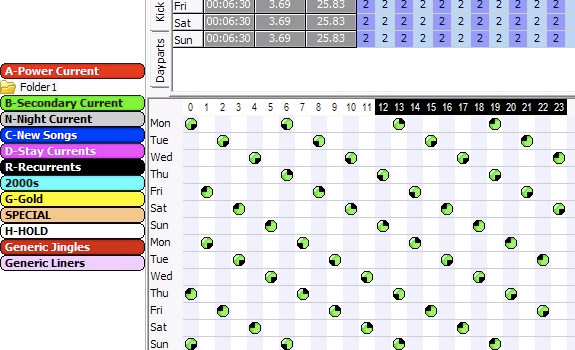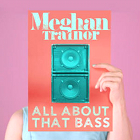Making music curation visible and shareable is a way to go forward for radio, says music content strategist Chris Price in part 2 of our talk.
Following broadcast radio lessons for Internet radio and music streaming services, we’ll cover best practices of music scheduling & programming that he’s learned in radio and television. We’ll also discuss the future of music radio, which can (re)claim the music curation position: “I remember a time when songs reacted at Shazam when they went on the radio, [but] now, songs go on the radio when they react at Shazam.”
“Be as excited by perfect rotations as by discovering hits”

The best radio music directors combine the art of programming with the science of scheduling (image: Powergold)
Balance your art & science
What are your top 3 tips for any music director on any platform, in any market?
“The best music programmers have a unique balance in their approach; almost in their personality.” He explains that great music schedulers have a strong creative ability: “The right-brain side is the passionate music fan who can spot a radio hit a mile off, which is an almost innate ability that some people have got. The left-brain side is the science part, which is the nerdy attention to detail. You must have seen a music programmer sit back in his chair and admire some beautifully diagonal stripes across the week. If you have somebody who can be as excited by perfect rotations as by discovering hits, you have the most powerful combination. Music is a very human thing. Don’t get too bogged down in science. Yes – be obsessed with housekeeping in your music library, your song rotations, and everything else, but always keep in mind that radio is an intimate medium. It’s that connection across the airwaves that a song can bring.”
 Put your audience first
Put your audience first
Price continues with one of the hardest (yet most important) lessons for those who start out as music directors. “It’s the idea that your passion for music is important, but that your personal opinion about a record is a really tiny part of why you should playlist it. You have to learn to leave your own opinions at the door when you arrive at work, in terms of placing your audience at the start and end of every playlist decision.”
Match your brand values
Another good piece of advice is to let your music policy reflect your station personality: “When you’re dating, the most attractive people tend to be the ones who know who they are, and know what they want. Make sure you know who your listeners are, but also who you are. Your music strategy should reflect the needs & wants of your audience, but also communicate your brand values. That might be at a macro level, in your music format for example, or down to the level of individual tracks. One of the first things that I was taught at BBC Radio 1 is that you should be able to turn on a station and, within 3 songs, know which one you’re listening to, without hearing any imaging or presenters. That would be good music programming.”
“We’re still in this old-world mentality”

Social engagement might become just as important as ratings books (photo: Thomas Giger, image: Facebook/BBC)
Visualize your audio content
Speaking of BBC Radio 1. Like many other stations, they experience that young people’s Time Spent Listening to radio is declining. How can CHR programmers make sure that radio stays relevant for the next generation – the AC listener of 20 years from now?
“I think that Ben Cooper has the most difficult job in the world. Getting young people to listen to radio? It’s tough. Today’s young generation has more visual demands on their attention. The station’s response has been to become a more visual medium. Joe Harland, their head of visualization, might be the only person to have that title anywhere in the radio industry.” Price sees their amount of YouTube channel subscribers and visualization of “everything from the Live Lounge to Innuendo Bingo” as an indication that their “listen, watch, share” strategy is working.
 Leverage your social stats
Leverage your social stats
He also thinks that in the future, social media engagement (like the number of YouTube subscribers, Twitter followers and Facebook likes) could become a key success metric. “If you could add them all up and present them as an aggregate score, you would see incredible numbers for Radio 1. We’re still in this old-world mentality where we measure stations against each other based on people ticking a box in a RAJAR diary.”
Separate your programming & sales
How did you, as a head of music, experience your move from public broadcaster BBC Radio 1 to a commercial environment with Viacom?
“I cut my teeth at the most fiercely editorial-independent place, meaning the BBC. It was quite a shock to go to MTV and talk about music in a way that was more transactional than emotional.” Price adds that Viacom, and specifically MTV, is one of those broadcasters who split out music programming and label relations by using different teams for each. “That distinction did give you some kind of editorial independence. But yeah, as much as Universal Music, MTV is in the business of making money. It’s a very different mindset, and although MTV is a huge brand, it’s not as important for breaking new artists as Radio 1. Record labels had much less focus on MTV as compared to Radio 1.” His office is decorated with gold discs, including Madonna, U2 and Travis, many of which he collected during his BBC years.
“We see music labels running competitions to improve their Shazam ranking”

Record companies know that music directors are keeping a close eye on Shazam popularity charts (image: Shazam)
Analyze your free resources
You’ve seen many approaches to music scheduling, shape-shifting from public radio to commercial TV; broadcast media to streaming services; humans to algorithms. Is radio still number 1 for music curation, or is it now mainly happening in other places?
“It seems like every year or so, a new piece of research comes out that says: radio is still the most important medium for discovering new music, and that’s gratifying to see. One of the most common complaints I hear is that the playlist decision-making process is based much more on research data than on gut instinct these days, which is understandable. You can look at a new song’s YouTube views, SoundCloud plays, Shazam rankings and iTunes chart position. You’ve got all these metrics at your disposal; why wouldn’t you use them to judge the comparative success of a certain track or artist?” It looks like overall, radio is currently in a more reactive mode: “I remember a time when songs reacted at Shazam when they went on the radio. Now, it tends to be that songs go on the radio when they react at Shazam.”
 (Re)claim your curation position
(Re)claim your curation position
Chris Price has the impression that even if broadcast radio is (still) ahead in terms of music programming crafts, streaming services become increasingly important for breaking new music. In reference to Will Page’s article on how Meghan Trainor made the UK chart without selling downloads (by becoming popular on Spotify), he signals that radio no longer has its “6-week exclusivity window” before a song becomes available anywhere else.
Let your gut speak
Program directors used record sales, request calls and gut feeling to playlist music. Today, they might use software to analyze PPM numbers or streaming statistics to see which individual song has a tendency to keep listeners tuned in or make audiences tune out. So what should be the focus?
“Gut instinct is number 1. In fact, the more data you have, the more important your gut is. You need to have strong opinions about what audiences want, especially in the public service space.” He explains that in a new song’s early stage, playlist decisions are more a matter of gut feeling (as there is relatively little data available for it yet), and that initiatives like BBC Introducing and In New Music We Trust are imperative for a public radio. Another focus point is Shazam: “In the UK, it’s the one tool that radio believes in. It’s quite an honest representation of interest in a song. We see music labels running competitions like: ‘Shazam this track for a chance to win’ to improve their Shazam ranking; therefore their chances of radio airplay.”
“Reward listeners for staying with you through challenging content”

New releases should be properly introduced, and strategically placed in between power songs (image: Thomas Giger)
Open your musical ears
To distinguish your music brand from others, is it just about songs that you play? Or also about songs that you leave out?
“Much has been made of the fact that Radio 1 doesn’t play U2 anymore. The same thing happened with Robbie Williams, who was obviously a superstar artist for Radio 1 back in the day. But as he matured, so did his audience. There was this period where he jokingly chastised Radio 1 for not playing him anymore. Then he snuck back on by featuring on a Dizzee Rascal track!” Music directors should not too quickly refuse to play a track: “Sometimes, stubbornly refusing to play a track can backfire. One big one I missed at Radio 1 was Teenage Dirt Bag by Wheatus. It was plugged like mad by the label and we were like: no, it’s not right for our music message and doesn’t fit. We dug our heels in. It became a number 1 hit. We kind of slipped it quietly onto Recurrent, haha.”
 Trust your gut feeling
Trust your gut feeling
Like a ‘late add’, haha. We spoke about how broadcast radio is an example for Internet radio regarding familiarity besides discovery. But some radio stations hardly play new music, as unfamiliar songs may cause tune-out.
“If you move away from contemporary hits, you’re going to the world of AC and eventually Gold. If you say: I’m a CHR station, then you have to take some risks every now and then.”
Package your challenging content
In which ways do you introduce new songs to your audience?
“I tend to think about content in terms of how challenging it is. Whether it’s a 12-minute link on the breakfast show or playing the new single by Slipknot, it’s either challenging or unchallenging; familiar or unfamiliar.” Price has learned that for radio stations, new music is among the most challenging content to air. “You have to cushion the effect of unfamiliar music with more familiar songs. Build in plenty of time in your clock for the presenter to ‘sell’ new music and show passion about why you think it’s a brilliant record; give audiences a great reason to fall in love with it as well. One thing I often point out to clients is that ‘recurrents’ and ‘rewards’ start with the same letters, and that’s precisely what recurrents are – they reward listeners for staying with you through challenging content.”
“Radio appears to be in rude health, even with huge demands on especially young people’s time”

Visualized content and social media are great ways to connect with young listeners (photo: Flickr / Franklin Heijnen)
Expand your station’s reach
Which music radio programming strategies have you found to work really well?
“It changes from station to station. For example, at BBC Radio 1 it would be completely anathema to play the same artist – let’s say, Beyoncé – twice in one show. That wouldn’t be true at Capital FM, for example. Their A-list separation is probably an hour or less. So, do you have a ‘no repeat’ strategy or do you play your songs more often? As a general rule, if you’re looking to increase your reach, you should tighten your rotations, so play your A-list and Recurrents more frequently. That way, ‘dial surfers’ are more likely to hear a song that they know and love, if you’re playing a smaller number of songs on a higher rotation. If you’re happy with your reach and want to increase your share, then you’re better off playing a larger number of songs fewer times – creating brand loyalty by not spinning the same songs over and over.”
 Mirror your target audience
Mirror your target audience
Do you believe that a station should have one music director who decides everything, or a group of people taking decisions based on democracy?
“At Radio 1 we had a music team of 4, and a playlist committee of about 12 people.” Price advises that your music team should include a representation of your (desired) listenership, in other words: a group with the right ratio of gender, ethnicity, and so on.
Make your station social
How do you see the future of music radio?
“We should take heart from the fact that radio appears to be in rude health, even with huge demands on especially young people’s time, whether it’s social media or streaming services or TV or gaming. Radio appears to be evolving in the face of that, and it’s an intimate, immediate medium.” He sees a correlation between radio stations and social media, as both are about connection and conversation. “To come back to listen, watch, share of BBC Radio 1, there couldn’t be a more perfect mix of ambitions to have. Listening and sharing have always been part of radio. The watching part is new, but radio has adapted to these challenges and will continue to thrive.” His expectation is that radio and music will always belong together: “Being able to see a new band on Tuesday night, play their record on Wednesday morning, and see audiences react by Wednesday afternoon… not many types of media can do that.”
Chris Price can be contacted through the website of his company New Slang Media.





Hi Thomas,
I just stumbled on your blog, and I LOVE IT!
I am a media consultant, working with one of the largest news radio stations in South America.
All the best,
John